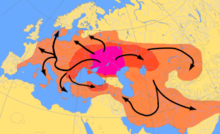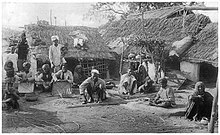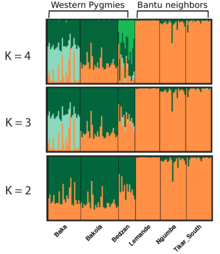Who We Are and How We Got Here by David Reich  Out of Africa and Back Again
 Kickoff edition | |
| Writer | David Reich |
|---|---|
| Subject | Human population genetics |
| Genre | Pop scientific discipline |
| Publisher | Oxford University Press |
| Publication appointment | 2018 |
| ISBN | 978-0-nineteen-882125-0 |
Who Nosotros Are and How We Got Here is a 2018 book on the contribution of genome-broad aboriginal DNA enquiry to homo population genetics past the geneticist David Reich. He describes discoveries fabricated by his group and others, based on analysis and comparison of aboriginal and modern Deoxyribonucleic acid from human populations effectually the world. Key to these is the finding that almost all human populations are mixtures resulting from multiple population migrations and cistron period.
Several reviewers accept praised the book for clearly describing pioneering work in a cut-border field of study.[ane] [two] Information technology has been criticized past numerous scientists and scholars for its handling of race,[3] though other commentators observe that nothing information technology says should give racists any comfort.[4] [5]
Context [edit]
David Reich is a geneticist who has studied aboriginal human genomes, comparing their patterns of mutations to detect which populations migrated and mixed throughout prehistory.[6] He was mentored by the population geneticist Luca Cavalli-Sforza, who from 1960 pioneered the attempt to friction match the study of human prehistory by archaeology and linguistics, using the limited genetic information bachelor at that time.[4]
Book [edit]



Yamnaya Corded ware culture, including this pot, corresponds to a stage in the westward migration.[4]
Publication [edit]
Who We Are and How We Got Here was published by Oxford University Printing in 2018, ISBN 978-0-19-882125-0. It is credited to David Reich lone, but he explains in the acknowledgements that the book grew from a detailed collaboration with his wife, Eugenie Reich.
The book is illustrated with monochrome maps, diagrams, and timelines. There are no photographs.
Summary [edit]
Since 2010, population geneticists have been able to sequence ancient human being Dna, recovering complete genomes,[4] in contrast to before approaches which relied on the far more abundant (and hence more hands recovered) mitochondrial Dna, which is present in many copies in each cell, and transmitted only via the maternal line. That early piece of work gave what Reich calls the "exciting" upshot that all modernistic humans are related to "Mitochondrial Eve", a woman who lived in Africa only about 160,000 years agone.[vii] [viii]
The whole genome recovery technique, using the especially hard bone from the inner ear of ancient skeletons — along with the genomes of modernistic people from unlike parts of the world, including especially some isolated populations — has made it possible to reconstruct prehistoric migrations and mixing of populations in the past 5,000 years, and to make reliable inferences well-nigh mixtures from much further dorsum in time.[4] The new cognition from genomics has overthrown many onetime assumptions near human origins.[iv]
Much of the work has focused on Western Eurasia, where in 1786 Sir William Jones discovered that Sanskrit and aboriginal Greek were related languages. Linguists came to recognise the Indo-European family of languages, spanning Germanic, Celtic, Italic, Iranian and northern Indian languages, just without explaining how these came to be. Reich showed that mod populations in Europe and northward Republic of india derive from mixing of native populations with Yamnaya people from the steppes north of the Black Body of water and the Caspian Sea some 5,000 years ago, in split up migrations to the west and the east.[4] [ix] Corded ware culture described by archæology corresponds to a stage in the westward migration.[four]
Reich observes that similar migrations and population mixtures characterise man prehistory on all continents.[4] Reich shows that people in Japan and Korea share some lxxx% of their DNA, implying migration; Polynesians migrated relatively recently, in just the past few thousand years, from the region of Taiwan. The evidence tin can upset long-held beliefs: Native American skeletons from 10,000 years ago do not appear to be related to the tribes living in those regions today who have been request for the aboriginal bones to be returned to them for burying.[7]
The Neanderthals are extinct, but part of their genome survives: Reich notes that all nowadays-twenty-four hour period not Sub-Saharan Africans take at least 2% of Neanderthal ancestry. Reich explains that somewhere between 100,000 and 50,000 years ago, modern humans mated with Neanderthals, and their descendants carried those genes all over the world. An ancient skeleton from Romania had upwardly to 9% Neanderthal DNA, so natural selection has been removing Neanderthal genes since those matings.[7]
Reception [edit]

Writer and intellectual Jared Diamond, in the New York Times, notes that geneticists can now arrive beyond studying the personal ancestries of participants in National Geographic'due south Genographic Project, which looked at small sections of their parents' Dna, namely their mother's mitochondrial DNA and their father's Y chromosome. By looking at Deoxyribonucleic acid from aboriginal bones, Reich can recover whole genomes. Diamond warns readers not to expect an oversimplified story:[7]
Population genetics is a complicated, fast-moving field with many uncertainties of interpretation. To tell that story to the broad public, and not only to scientists reading specialty journals, is a big challenge. Reich explains these complications besides as any geneticist could; others rarely even effort.[7]
Peter Forbes, in The Guardian, calls the book "thrilling in its clarity and its scope."[iv] In Forbes'southward view, Reich handles racist abuses of human origin stories, such as Nazi ideology, "commendably". Forbes writes that Reich explains how aboriginal DNA teaches a single general lesson, that the human population of any particular place has repeatedly changed since the last ice age. Any supposed "mystical, longstanding" link between some people and a place based on some kind of racial purity (as reflected in the Nazi slogan of "blood and soil"), is in Reich's words "flying in the face of hard science".[4]
Clive Cookson, in the Financial Times, writes that one of the outset and most surprising impacts of genomics is in homo prehistory, and Reich is the showtime leading practitioner to write a pop book most this. Cookson calls the book[ane]
a marvelous synthesis of the field: the technology for purifying and decoding DNA from old bones; what the findings tell us near the origins and movements of people on every inhabited continent; and the ethical and political implications of the enquiry.[1]
Cookson notes that Reich dismisses worries that DNA evidence of differences between populations is "racism in genetic habiliment",[1] and that on the opposite, the "unsuspected degree of mixing"[i] in every part of human history makes old ideas of racial purity "absurd".[1]

Bell-shaped Beaker pots, establish in Western Europe c. 2900–1800 BC
The archeologist and geneticist Turi King, in Nature, writes that Reich's laboratory "has developed some of the almost sophisticated statistical and bioinformatics techniques available. Using computers, they painstakingly reconstruct genomic information from fragments of Dna from aboriginal individuals. They so drill downwards in search of a new understanding of homo history." King notes that Reich's group helped to show that "Neanderthals interbred with the ancestors of all modern humans descended from Europeans, Asians and other non-Africans." Their work is showing the "tremendous caste to which populations globally are blended, repeatedly, over generations." Rex notes, too, that Reich reflects on the dangers of misinterpretation by racists, who "pick and choose results", or others who opt to "sweep [genetic] differences nether the carpet". But, King argues, echoing Reich, nosotros do need "a non-loaded way to talk about genetic diverseness and similarities in populations", and Reich has begun to do that.[eleven]
The economist Tyler Cowen calls the volume "truly excellent, readable and informative". Cowen insists it is "a scientific discipline book, not a 'race book'", stating that although it has engendered "some public controversy", he is confident that no circumspect reader could feel "affirmed in racist beliefs".[5]
The educator Darcy Moore of the University of Wollongong calls the book "highly recommended" but finds some of Reich's conclusions "puzzling and in need of much more research and caption." A case in point is Reich's statement that the population of Britain was 90% replaced past the incoming Indo-European-speaking people at the start of the Beaker menses. Moore comments that he and the archaeologist Barry Cunliffe (who along with the archaeologist Colin Renfrew praises the book on its dorsum cover) agreed in an email give-and-take that such a radical alter was hard to understand.[12]

Admixture plot of Western African Pygmies and their Bantu neighbours
A review past Razib Khan, who is cited in the book, recommends the book to a wide audience, arguing that it "catches [one] up to the land-of-the-fine art noesis that we have in terms of human being history, deep and prehistoric." He includes experts in that audience: "I've talked to plenty of people who work in evolutionary genomics who are not totally up-to-speed on the ancient DNA revolution. They too would benefit from reading Who Nosotros Are and How We Got Here front to back. I know people who piece of work in the field of cultural evolution, who would also benefit from reading Who We Are and How We Got Here. I know behavior geneticists who would benefit from reading Who We Are and How We Got Here. And then forth." Khan concedes that the volume "is not rich with the same stylistic flourish and engagement equally one might notice in a popularization past Steven Pinker or Richard Dawkins" merely that it is a "serious volume that is earnest in focusing on the substance of the science showtime."[ii]
The paleogenomics researcher Maria C. Avila Arcos reviewed the book in Science magazine, arguing that "troubling traces of biocolonialism undermine an otherwise eloquent synthesis of ancient genome inquiry."[thirteen] She calls Reich's account graceful, combining his personal opinions with "difficult science"[13] (Reich'due south phrase). She accepts that the book is "scientifically solid and comprehensive",[xiii] just argues that information technology "raises some concerns",[thirteen] since in her view Reich overlooks the conflict of interest between the needs of researchers to gather aboriginal human being Deoxyribonucleic acid specimens and the rights of the ofttimes marginalised populations that descend from those ancestors.[13]
The anthropologist John Hawks, writing in the Wall Street Journal, observes that Reich was surprised that the "cyclopedia of virtually-mythological history with genetic fact"[xiv] in the migrations in Bharat was "a potential political bombshell";[14] he notes that Reich avoided it by not talking about "Indo-European invaders at all",[fourteen] writing only that "No grouping in India can claim genetic purity".[xiv] In Hawks'southward view, Reich "seems a contradiction: Rising to the top of human genetics, he nonetheless exhibits incredible naiveté"[14] in affairs such equally when German language scientists withdrew from a newspaper that seemed to them "uncomfortably shut to pre-Nazi racial theories",[14] or when Native American specimen donors wished to limit the utilize of their DNA. Hawks argues that scientific discipline needs to help people to encounter the humanity of the expressionless ancestors, and finds Reich'south approach potentially dehumanizing.[14]
An open letter titled "How Not To Talk About Race And Genetics" by a group of 67 scientists and scholars criticizes Reich's use of the term "race" in this book.[3] The group welcomes Reich's challenge to the "misrepresentations about race and genetics"[three] made past the science writer Nicholas Wade and the molecular biologist James Watson, but warns that his skill with genomics "should not be dislocated with a mastery of the cultural, political, and biological meanings of human groups."[3] The listing of signatories includes geneticists Joseph L. Graves Jr. and Erika Hagelberg, biologists Anne Fausto-Sterling and Robert Pollack, biological anthropologists Jonathan Yard. Marks, Agustín Fuentes and Alan H. Goodman, and sociologists Alondra Nelson, Troy Duster and France Winddance Twine.
According to computational biologist Hussein Mohsen, Reich'due south examples "conflated ancestry with race, relied on the quantitative reductionism of averages, and failed to address the everyday ramifications of pathologizing socially constructed (racial or bequeathed) categories to which millions of human beings belong or were historically forced to."[15] In dissimilarity to Reich'south analysis, Mohsen cites the open alphabetic character "How Not To Talk Nigh Race And Genetics" as an authentic representation of "the complication of the race concept and stark limitations of quantitative genetics to grasp its fluid histories."[15]
References [edit]
- ^ a b c d e f Cookson, Clive (23 March 2018). "Who We Are and How We Got Here by David Reich — out of Africa and back once more? | How ancient DNA is showing early human being migrations to exist more circuitous than in one case thought". Financial Times. Archived from the original on 24 March 2018. Retrieved 7 May 2018. (subscription required)
- ^ a b Khan, Razib (18 March 2018). "A preview review of Who We Are and How Nosotros Got Hither: Ancient DNA and the New Scientific discipline of the Human Past". Gene Expression . Retrieved 26 July 2018.
- ^ a b c d Kahn, Jonathan, and 66 other signatories. "How Not To Talk Most Race And Genetics". BuzzFeed News. Retrieved 5 May 2018.
- ^ a b c d east f 1000 h i j thousand Forbes, Peter (29 March 2018). "Who We Are and How We Got Here by David Reich review – new findings from ancient Dna". The Guardian . Retrieved half dozen May 2018.
- ^ a b Cowen, Tyler. "*Who We Are and How Nosotros Got Here*, past David Reich". Retrieved 7 May 2018.
- ^ Callaway, Ewen (17 December 2015). "365 days: Nature's 10 | DAVID REICH: Genome archaeologist". Nature Magazine. Retrieved 6 May 2018.
- ^ a b c d e Diamond, Jared (20 April 2018). "A Brand-New Version of Our Origin Story | 'WHO Nosotros ARE AND HOW WE GOT Hither' Ancient DNA and the New Scientific discipline of the Human By Past David Reich". The New York Times.
- ^ Reich 2018, pp. four–5.
- ^ Haak, Wolfgang; Lazaridis, Iosif; Patterson, Nick; et al. (two March 2015). "Massive migration from the steppe was a source for Indo-European languages in Europe". Nature. 522 (7555): 207–211. doi:10.1038/nature14317. PMC5048219. PMID 25731166.
- ^ Reich 2018, pp. 140–146.
- ^ King, Turi (13 March 2018). "Sex activity, power and ancient DNA | Turi King hails David Reich'southward thrilling account of mapping humans through time and identify" (PDF). Nature. 555 (7696): 307–308. doi:x.1038/d41586-018-02964-v. PMID 32094709.
- ^ Moore, Darcy (27 April 2018). "Who We Are and How We Got Here by David Reich #review". Retrieved 7 May 2018.
- ^ a b c d eastward Avila Arcos, Maria C. (17 April 2018). "Troubling traces of biocolonialism undermine an otherwise eloquent synthesis of ancient genome research". Science. Retrieved 5 May 2018.
- ^ a b c d due east f g Hawks, John (10 Apr 2018). "'Who We Are and How We Got Here' Review: Ghosts in the Genome". The Wall Street Journal. Archived from the original on 21 May 2021. Retrieved xix November 2018.
- ^ a b Mohsen, Husein (27 March 2020). "Race and Genetics: Somber History, Troubled Present". Yale Journal of Biological Medicine. 93 (1): 215–219. PMC7087058. PMID 32226350.
Sources [edit]
- Reich, David (2018). Who Nosotros Are and How We Got Hither. Oxford University Press. ISBN978-0-19-882125-0.
External links [edit]
- David Reich on Radio Boston
- Reich interview on BBC
- "How Not To Talk About Race And Genetics"
Source: https://en.wikipedia.org/wiki/Who_We_Are_and_How_We_Got_Here
0 Response to "Who We Are and How We Got Here by David Reich  Out of Africa and Back Again"
Post a Comment